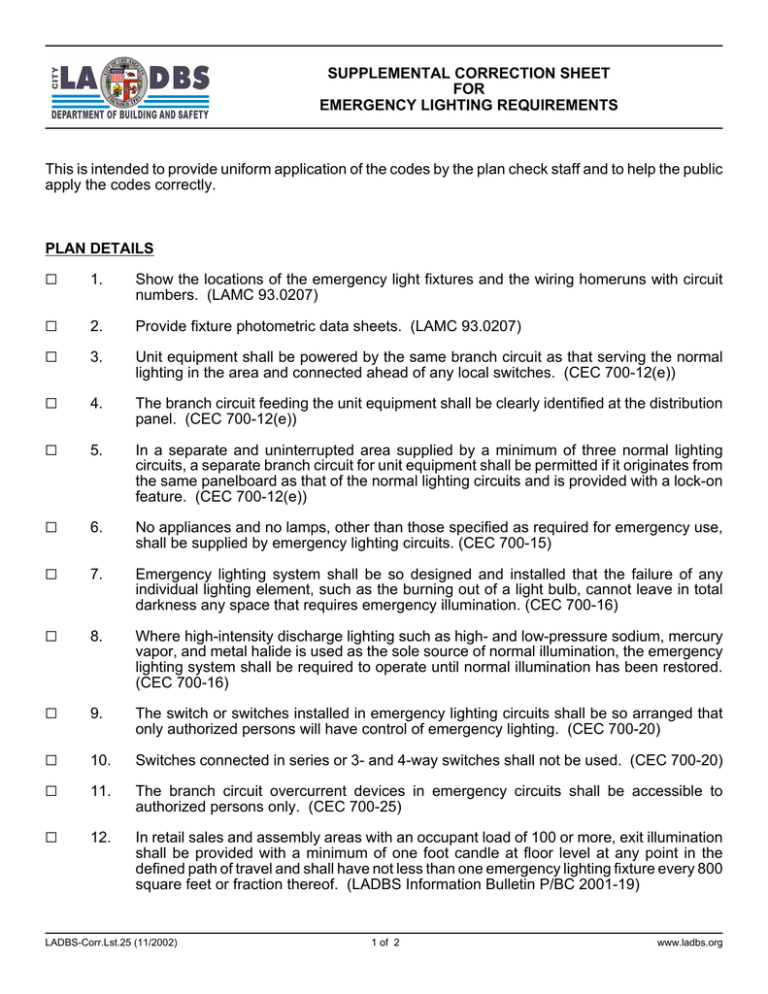Emergency Lighting Requirements
advertisement

SUPPLEMENTAL CORRECTION SHEET FOR EMERGENCY LIGHTING REQUIREMENTS This is intended to provide uniform application of the codes by the plan check staff and to help the public apply the codes correctly. PLAN DETAILS G 1. Show the locations of the emergency light fixtures and the wiring homeruns with circuit numbers. (LAMC 93.0207) G 2. Provide fixture photometric data sheets. (LAMC 93.0207) G 3. Unit equipment shall be powered by the same branch circuit as that serving the normal lighting in the area and connected ahead of any local switches. (CEC 700-12(e)) G 4. The branch circuit feeding the unit equipment shall be clearly identified at the distribution panel. (CEC 700-12(e)) G 5. In a separate and uninterrupted area supplied by a minimum of three normal lighting circuits, a separate branch circuit for unit equipment shall be permitted if it originates from the same panelboard as that of the normal lighting circuits and is provided with a lock-on feature. (CEC 700-12(e)) G 6. No appliances and no lamps, other than those specified as required for emergency use, shall be supplied by emergency lighting circuits. (CEC 700-15) G 7. Emergency lighting system shall be so designed and installed that the failure of any individual lighting element, such as the burning out of a light bulb, cannot leave in total darkness any space that requires emergency illumination. (CEC 700-16) G 8. Where high-intensity discharge lighting such as high- and low-pressure sodium, mercury vapor, and metal halide is used as the sole source of normal illumination, the emergency lighting system shall be required to operate until normal illumination has been restored. (CEC 700-16) G 9. The switch or switches installed in emergency lighting circuits shall be so arranged that only authorized persons will have control of emergency lighting. (CEC 700-20) G 10. Switches connected in series or 3- and 4-way switches shall not be used. (CEC 700-20) G 11. The branch circuit overcurrent devices in emergency circuits shall be accessible to authorized persons only. (CEC 700-25) G 12. In retail sales and assembly areas with an occupant load of 100 or more, exit illumination shall be provided with a minimum of one foot candle at floor level at any point in the defined path of travel and shall have not less than one emergency lighting fixture every 800 square feet or fraction thereof. (LADBS Information Bulletin P/BC 2001-19) LADBS-Corr.Lst.25 (11/2002) 1 of 2 www.ladbs.org G 13. In covered parking garages (including the top level) with an occupant load of 100 or more, emergency exit illumination shall provide a minimum of one foot candle at floor level at any point of a defined path of travel, and no portion of the garage is more than 70 feet, measured horizontally, from a light fixture. (LADBS Information Bulletin P/BC 2001-19) G 14. Unit equipment is not permitted in the following occupancies: G G a. b. G G c. d. G e. New high rise buildings permitted subsequent to July 1974. Existing buildings that currently have a emergency generator or storage battery systems. Buildings where the code specifically requires a emergency generator. All health care facilities when required by Title 24 of the California Code of Regulations or Article 517 of the CEC. All assembly occupancies and the exiting system from those occupancies to the exterior of the building where a single assembly occupancy, room, or area has 500 or more occupants. (LADBS Information Bulletin P/BC 2001-19) CALCULATIONS G 1. Provide foot-candle (fc) calculation showing that designed emergency lighting system will provide minimum of 1.0 fc (10.76 lux) illumination at the floor level. (LABC 1003.2.9.1) G 2. For emergency lights supplied from a central battery system, provide foot-candle calculation to show that required 1.0 fc (10.76 lux) illumination level is maintained at the end of the required time period of 1 ½ hours under full load condition, considering the voltage level drops. (LABC 1003.2.9.1) G 3. Provide battery load calculation showing that central storage battery rating is sufficient to supply the required power to the emergency lights for the required 1 ½ hours under full load condition, without the voltage applied to the load falling below 87 ½ percent of normal. (CEC 700-12(a)) G 4. Provide foot-candle calculation showing that designed emergency lighting system in auditoriums, theaters, concert or opera halls, and similar assembly uses will provide minimum of 0.2 fc (2.15 lx) when the illumination level is reduced during performances. Also provide a circuit diagram and specification sheet illustrating how the required illumination of minimum 1.0 fc (10.76 lx) will be automatically restored upon activation of a premise’s fire alarm system when such system is provided. (LABC 1003.2.9.1) NOTES ON PLANS G 1. All equipment shall be approved for use on emergency systems. Provide evidence showing the following equipment are listed as emergency use equipment by a recognized testing laboratory: .(California Electrical Code, CEC 110-3, 700-3 LADBS-Corr.Lst.25 (11/2002) 2 of 2 www.ladbs.org

